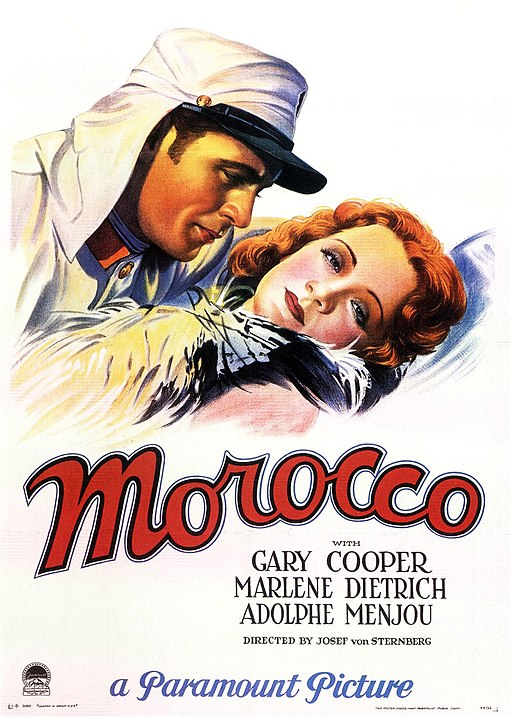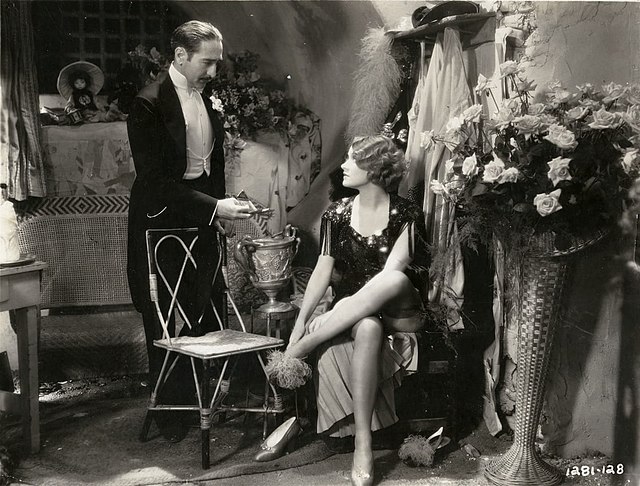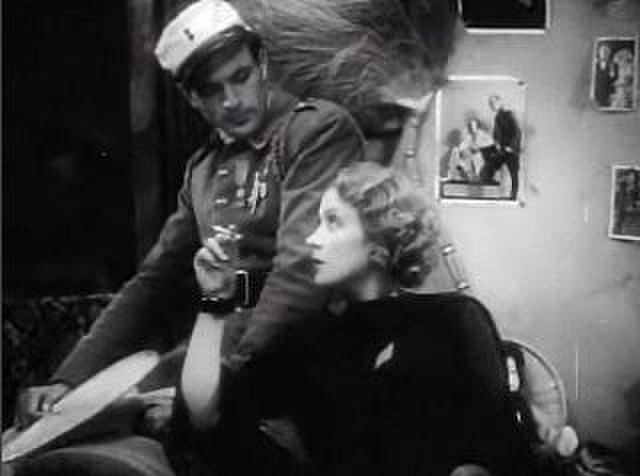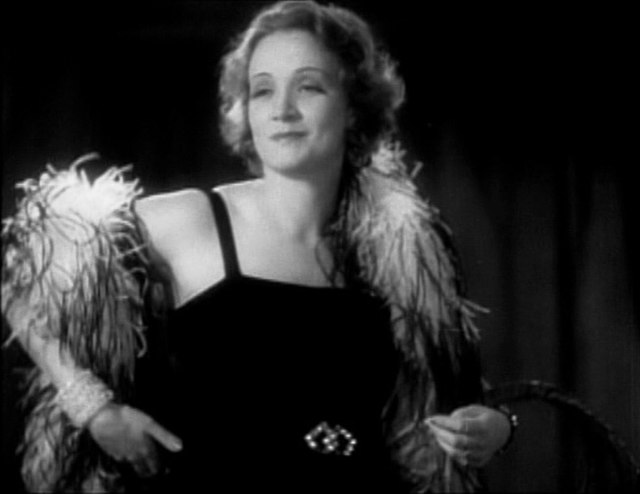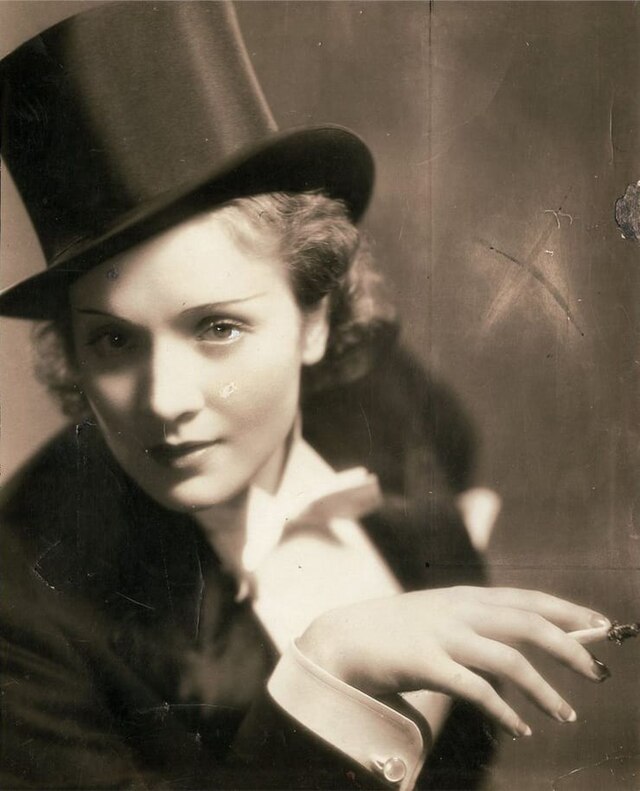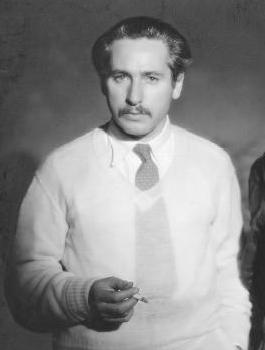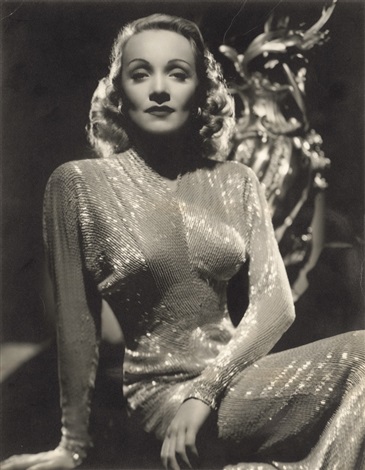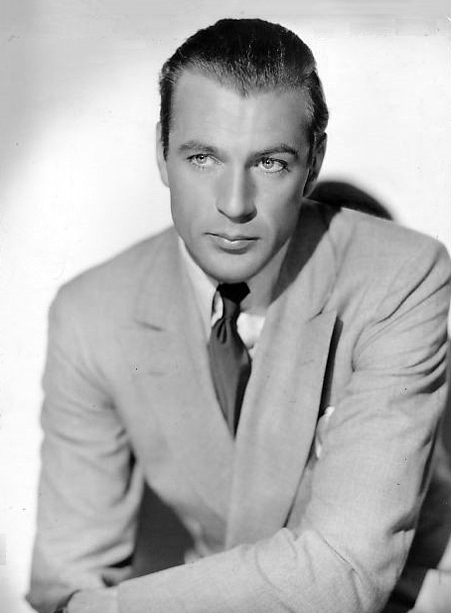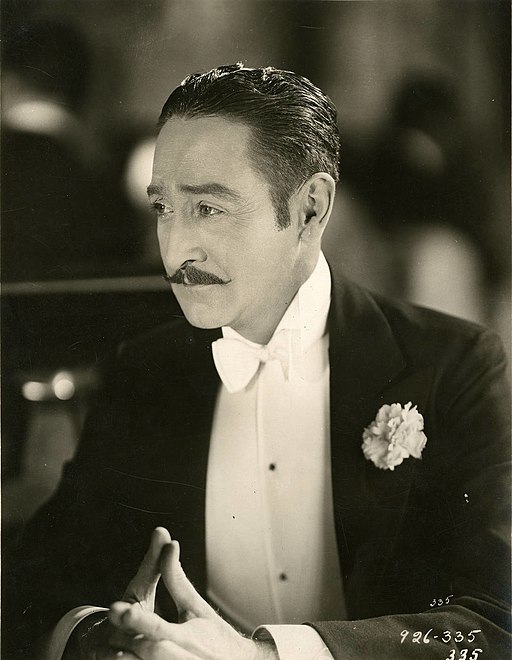Morocco - 1930
back| Released by | Paramount Pictures |
| Director | Josef von Sternberg |
| Producer | Hector Turnbull |
| Script | Jules Furthman (screenplay), Benno Vigny |
| Cinematography | Lee Garmes |
| Music by | Karl Hajos (musical score), W. Franke Harling (musical score) |
| Running time | 92 minutes |
| Film budget | $776,000 |
| Box office sales | $1.7 million |
| Main cast | Marlene Dietrich - Gary Cooper - Adolphe Menjou |
Morocco
An Exotic Romance in the North African Desert
Morocco (1930), directed by Josef von Sternberg, stars Marlene Dietrich as Amy Jolly, a disillusioned nightclub singer who falls for Tom Brown, a French Foreign Legionnaire played by Gary Cooper.
The film is renowned for Dietrich's androgynous tuxedo performance and its daring exploration of gender norms and romantic sacrifice.
Morocco received four Oscar nominations, cementing Dietrich's status as a Hollywood icon and influencing future cinematic portrayals of complex, independent women.
Related
Morocco – 1930
Summary
Morocco is a romantic drama set against the exotic backdrop of North Africa, directed by Josef von Sternberg and starring Marlene Dietrich and Gary Cooper. The film opens with the arrival of Amy Jolly (Marlene Dietrich), a world-weary singer, in Morocco. She has come to seek a fresh start, performing at a local nightclub.
At the nightclub, Amy meets Tom Brown (Gary Cooper), a handsome and carefree soldier in the French Foreign Legion. There is an instant attraction between the two, despite their vastly different backgrounds and the seemingly insurmountable barriers between them. Tom's casual, almost nonchalant demeanor hides a depth of feeling, while Amy's glamorous exterior conceals her vulnerability.
La Bessière (Adolphe Menjou), a wealthy and sophisticated man, also becomes infatuated with Amy and proposes marriage, offering her a life of security and comfort. However, Amy is drawn to the unpredictable and passionate Tom. Their relationship is tumultuous, marked by moments of intense connection and misunderstandings.
Amy's feelings for Tom are put to the test when he is sent on a dangerous mission. As he departs, she gives him a medallion as a token of her love. In Tom's absence, La Bessière continues to pursue Amy, offering her the stability that Tom cannot. Despite this, Amy remains steadfast in her love for Tom.
The climax of the film occurs when Tom returns, only to find Amy performing at the nightclub. Misunderstandings and jealousy come to a head, but ultimately, Amy decides to follow her heart. In a powerful and iconic final scene, Amy joins the ranks of women following the Legionnaires into the desert, determined to be with Tom, no matter the cost.
Analysis
Morocco is notable for its evocative atmosphere, created through Josef von Sternberg's direction and Lee Garmes' cinematography. The film's visual style is lush and atmospheric, with striking use of light and shadow that enhances the romantic and exotic elements of the story.
Marlene Dietrich's performance as Amy Jolly is one of the film's standout features. Her portrayal of a strong yet vulnerable woman, torn between love and self-preservation, is nuanced and compelling. Dietrich's androgynous charm and sultry presence add a layer of complexity to her character, making her one of the most memorable screen icons of the era. The scene where she performs "Falling in Love Again" while dressed in a tuxedo is particularly famous, highlighting her magnetic screen presence and the film's subtle subversion of gender norms.
Gary Cooper's Tom Brown is the quintessential romantic hero—brave, rugged, and emotionally distant, yet capable of deep affection. His chemistry with Dietrich is palpable, and their interactions drive the emotional core of the film. Adolphe Menjou's La Bessière provides a contrasting figure to Tom, representing the allure of wealth and stability versus the unpredictability of passionate love.
Thematically, Morocco explores the tension between love and duty, as well as the choices individuals make in the pursuit of happiness. The film delves into the complexities of romantic relationships, particularly the sacrifices and risks involved in following one's heart. Amy's decision to abandon a life of comfort for an uncertain future with Tom underscores the film's romantic idealism and its celebration of personal freedom.
In addition to its romantic narrative, Morocco also reflects the colonial context of its setting. The depiction of the Foreign Legion and the exoticized portrayal of North Africa are indicative of the era's attitudes and cinematic trends. The film's romanticism is intertwined with a sense of adventure and escapism, characteristic of early 20th-century Hollywood.
Overall, Morocco is a landmark film that combines stunning visual artistry with powerful performances and a poignant love story. Its influence can be seen in subsequent romantic dramas, and it remains a testament to the enduring appeal of classic Hollywood cinema.
Classic Trailer of Morocco from 1930:
Full Cast of Morocco:
- Marlene Dietrich as Amy Jolly
- Gary Cooper as Tom Brown
- Adolphe Menjou as Monsieur La Bessière
- Ullrich Haupt as Adjutant Caesar
- Eve Southern as Madame Caesar
- Francis McDonald as Sergeant Tatoche
- Paul Porcasi as Lo Tinto
- Emile Chautard as Amy's Dresser
- Juliette Compton as Anna Dolores
- Michael Visaroff as French Officer
- Albert Conti as French Officer
- Theresa Harris as Inky (uncredited)
- Émile Chautard as Amy's dresser (uncredited)
- Félix Valle as Bartender (uncredited)
- Yola d'Avril as Souvenir Salesgirl (uncredited)
Artistic Direction of Josef von Sternberg:
Josef von Sternberg's direction in Morocco is a masterclass in creating atmospheric and emotionally resonant cinema. His approach combines meticulous visual composition, innovative use of lighting, and a deep understanding of character dynamics, resulting in a film that is both visually stunning and emotionally compelling.
Visual Composition and Cinematography
Von Sternberg's direction is marked by his impeccable attention to visual detail. He collaborates effectively with cinematographer Lee Garmes to create a rich, textured visual landscape. The use of light and shadow is particularly notable, contributing to the film's moody and exotic atmosphere. The chiaroscuro lighting not only enhances the visual appeal but also underscores the emotional undercurrents of the narrative.
The film's framing and composition are deliberate and evocative. Von Sternberg often uses deep focus and carefully orchestrated mise-en-scène to draw viewers into the world of Morocco. Each scene is composed with an eye for balance and symmetry, creating a sense of order amidst the film's emotional chaos. This meticulous composition helps to establish the film's setting as both a physical location and a metaphorical space for the characters' inner turmoil.
Characterization and Performances
Von Sternberg's direction shines in his ability to draw out nuanced performances from his actors. Marlene Dietrich's portrayal of Amy Jolly is a testament to von Sternberg's skill in guiding his actors to deliver complex, layered performances. Dietrich's transformation from a world-weary singer to a woman willing to risk everything for love is conveyed with subtlety and depth. Von Sternberg's direction allows Dietrich to explore the vulnerability and strength of her character, making Amy Jolly one of the most memorable heroines in cinema history.
Gary Cooper, as Tom Brown, benefits from von Sternberg's ability to elicit a performance that balances stoicism with hidden emotional depth. The chemistry between Cooper and Dietrich is palpable, driven by von Sternberg's keen understanding of romantic tension. Adolphe Menjou's portrayal of La Bessière is equally compelling, with von Sternberg highlighting the character's sophistication and underlying desperation.
Thematic Depth and Symbolism
Von Sternberg imbues Morocco with thematic richness, exploring the complexities of love, duty, and personal freedom. His direction emphasizes the film's central themes through visual motifs and symbolic imagery. For instance, the recurring use of mirrors and reflections symbolizes the duality of the characters' lives and their inner conflicts. The stark contrasts between light and shadow mirror the moral and emotional dilemmas faced by the protagonists.
The exotic setting of Morocco serves as more than just a backdrop; it becomes a character in its own right, reflecting the allure and danger of the unknown. Von Sternberg's direction captures the sense of adventure and escapism that pervades the film, while also critiquing the colonial context of its setting. The foreign legionnaires, the desert landscapes, and the bustling nightclub all contribute to the film's exploration of displacement and longing.
Pacing and Narrative Structure
The pacing of Morocco is carefully controlled, allowing the narrative to unfold in a way that maintains tension and engagement. Von Sternberg balances moments of intense drama with quieter, more introspective scenes, creating a rhythm that mirrors the emotional journey of the characters. The narrative structure is straightforward yet effective, with von Sternberg focusing on the development of the central relationships and the internal conflicts of the characters.
Conclusion
Josef von Sternberg's direction in Morocco is a tour de force of cinematic artistry. His ability to blend visual splendor with deep emotional resonance makes the film a timeless classic. Through his meticulous composition, innovative use of lighting, and skillful direction of actors, von Sternberg creates a film that is both a visual feast and a profound exploration of love and desire. Morocco remains a testament to von Sternberg's directorial genius and his unique vision in the annals of film history.
Iconic Performance of Marlene Dietrich:
Marlene Dietrich's performance as Amy Jolly in Morocco is iconic, establishing her as a major star in Hollywood and showcasing her remarkable talent and screen presence. Dietrich's portrayal of Amy Jolly is a study in complexity, combining strength, vulnerability, and sensuality in a way that captivates and resonates with audiences.
Character Introduction and Initial Impression
Dietrich's first appearance in the film is unforgettable. Arriving in Morocco as a nightclub singer seeking a new beginning, she immediately captures attention with her poised and enigmatic presence. From her very first scene, Dietrich exudes a sense of world-weariness and sophistication that sets the tone for her character. Her entry into the nightclub, dressed in a tuxedo and performing the song "Quand L'amour Meurt" ("When Love Dies"), is particularly striking. This scene not only highlights Dietrich's musical talent but also establishes her as a figure of allure and mystery.
Emotional Depth and Vulnerability
Throughout the film, Dietrich masterfully conveys the emotional depth of Amy Jolly. Beneath her confident exterior lies a woman who has experienced pain and disillusionment. Dietrich's eyes, often filled with a melancholic intensity, communicate a history of heartache and longing. This emotional vulnerability is most evident in her interactions with Gary Cooper's character, Tom Brown. Dietrich's portrayal of Amy's growing affection for Tom is nuanced, showing both the excitement of new love and the fear of inevitable loss.
In scenes where Amy grapples with her feelings for Tom, Dietrich's performance is both subtle and powerful. Her body language, from the way she leans into Tom during their intimate conversations to the slight hesitations before expressing her feelings, reflects the inner conflict of a woman torn between love and self-preservation. This ability to convey complex emotions with minimal dialogue is a testament to Dietrich's acting prowess.
Chemistry with Co-stars
The chemistry between Marlene Dietrich and Gary Cooper is one of the film's highlights. Dietrich's Amy Jolly and Cooper's Tom Brown share a palpable attraction that is both passionate and tender. Their interactions are charged with an electric tension, underscoring the push-and-pull dynamic of their relationship. Dietrich's performance in these scenes is marked by a blend of assertiveness and vulnerability, making the romance both believable and compelling.
Dietrich also shares significant scenes with Adolphe Menjou's character, La Bessière. Her interactions with La Bessière reveal a different aspect of Amy's character—her practicality and desire for stability. Dietrich skillfully navigates these dual relationships, showcasing Amy's internal struggle between the safe choice (La Bessière) and the risky, passionate one (Tom).
Iconic Moments and Symbolism
Several iconic moments in Morocco are driven by Dietrich's performance. One of the most memorable is her tuxedo-clad performance at the nightclub, where she playfully kisses a woman in the audience. This scene was groundbreaking for its time, challenging conventional gender norms and highlighting Dietrich's androgynous appeal. Dietrich's confident demeanor and playful charm in this scene symbolize Amy's defiance of societal expectations and her embrace of individuality.
Another pivotal moment is the film's climactic scene, where Amy decides to follow Tom into the desert. Dietrich's portrayal of Amy's resolve and determination is powerful, capturing the character's willingness to sacrifice everything for love. The final image of Amy joining the ranks of women trailing after the Legionnaires, her face illuminated by a mix of hope and desperation, is a testament to Dietrich's ability to convey complex emotions through visual expression alone.
Impact and Legacy
Marlene Dietrich's performance in Morocco is a defining moment in her career and in cinematic history. Her portrayal of Amy Jolly established her as a symbol of both glamour and depth, influencing the portrayal of strong, independent women in film for generations to come. Dietrich's ability to blend emotional complexity with a commanding screen presence makes her performance in Morocco timeless and unforgettable.
In summary, Marlene Dietrich's performance in Morocco is a masterful blend of strength, vulnerability, and sensuality. Her nuanced portrayal of Amy Jolly, combined with her magnetic chemistry with her co-stars and her ability to convey deep emotional truths with subtlety, cements her status as one of the most iconic actresses of her time. Dietrich's work in Morocco remains a benchmark for excellence in acting, showcasing her extraordinary talent and enduring appeal.
Notable Film Lines:
- Amy Jolly (Marlene Dietrich): "I've told you my name. What else do you want to know?"
- This quote reflects Amy's guarded nature and her reluctance to open up about her past.
- Amy Jolly: "Anyone can buy a woman for a few francs. But in a woman's heart, there is always one man. He does not need to buy her; she gives herself to him freely. Tonight I have found such a man."
This quote highlights Amy's romantic ideals and her belief in genuine love, despite her cynicism.
- Tom Brown (Gary Cooper): "You'd better go easy on the perfume. Remember, you're in the desert now."
Tom's practical advice to Amy contrasts with her glamorous persona, emphasizing the harsh reality of their environment.
- Monsieur La Bessière (Adolphe Menjou): "The woman who needs all the adventures and excitement the world can offer will be happy with a man who needs nothing but her."
This quote underscores La Bessière's understanding of Amy's character and his offer of a stable relationship.
- Amy Jolly: "We’re both heading for the same thing... I hope we find it."
This line signifies Amy's and Tom's shared sense of searching for meaning and connection.
- Tom Brown: "I don't know. I don't seem to care much about anything anymore—except you."
Tom's admission reveals his deepening feelings for Amy and his disillusionment with life.
- Amy Jolly: "I seem to have found what I was looking for. I think I'll stick around for a while."
This quote illustrates Amy's realization that she has found something meaningful in her relationship with Tom.
- Amy Jolly (singing): "Falling in love again, never wanted to. What am I to do? I can't help it."
The lyrics of this song, performed by Amy in the nightclub, encapsulate her resignation to the inevitability of falling in love despite her attempts to avoid it.
- Amy Jolly: "You’d better kiss me goodbye, because you’ll never see me again."
Amy's farewell to Tom before he departs on a mission reflects her fear of losing him and the transient nature of their relationship.
- Amy Jolly: "Wherever you go, I'll follow."
This quote from the climactic scene emphasizes Amy's commitment and determination to be with Tom, regardless of the hardships.
Awards and Recognition:
Academy Awards (Oscars)
Morocco received four nominations at the 4th Academy Awards:
- Best Actress in a Leading Role - Marlene Dietrich
- Best Director - Josef von Sternberg
- Best Art Direction - Hans Dreier
- Best Cinematography - Lee Garmes
While the film did not win any of these awards, the multiple nominations highlight its recognition by the Academy for its artistic and technical achievements.
Additional Recognitions
Although Morocco did not win any Oscars, it remains a significant film in cinema history due to its influence and the critical acclaim it garnered at the time of its release. The performances, particularly by Marlene Dietrich, and the direction by Josef von Sternberg, have been celebrated and continue to be studied and appreciated in film history and analysis.
Classic Scenes from Morocco:
Amy Jolly's Nightclub Performance in a Tuxedo
One of the most memorable scenes in Morocco is Marlene Dietrich's first performance at the nightclub, where she sings "Quand L'amour Meurt" dressed in a tuxedo. This scene is significant for several reasons:
- Gender Subversion: Dietrich's choice of attire—a tuxedo traditionally worn by men—challenged gender norms of the time and added a layer of androgynous appeal to her character.
- Audience Interaction: During her performance, Amy Jolly kisses a female audience member on the lips. This act was provocative and daring for its time, highlighting Dietrich's bold and uninhibited screen persona.
- Visual Impact: The scene is beautifully shot with moody lighting, emphasizing Dietrich's enigmatic and seductive presence.
The Sandstorm Scene
Another classic scene occurs when Tom Brown (Gary Cooper) and Amy Jolly are caught in a sandstorm. This moment is visually striking and emotionally intense:
- Symbolism: The sandstorm represents the tumultuous nature of their relationship and the external forces threatening to tear them apart.
- Emotional Connection: Amidst the chaos, Tom and Amy share a tender and passionate kiss, symbolizing their deepening bond despite the uncertainties surrounding them.
Tom Brown's Departure
The scene where Tom Brown leaves for a dangerous mission with the Foreign Legion is pivotal:
- Heartfelt Goodbye: Amy gives Tom a medallion as a token of her love, and their farewell is filled with emotional weight. The uncertainty of whether they will see each other again adds to the poignancy of the moment.
- Character Development: This scene highlights Amy's internal conflict—her fear of losing Tom and her hope for his return—showing her vulnerability and depth of feeling.
Amy's Final Decision
The film's climax features one of the most iconic scenes in cinema history:
- Amy's Transformation: After performing at the nightclub, Amy decides to follow Tom into the desert, leaving behind her glamorous life. This decision is a powerful statement of her love and commitment.
- Iconic Imagery: The final shot of Amy walking barefoot through the desert, joining the ranks of women following the Legionnaires, is visually and emotionally impactful. It symbolizes her willingness to sacrifice everything for love and her determination to be with Tom, no matter the cost.
Amy's Seductive Performance of "Falling in Love Again"
Another standout scene is Amy's performance of the song "Falling in Love Again":
- Emotional Resonance: The lyrics of the song mirror Amy's own experiences with love, adding a layer of personal reflection to her performance.
- Cinematic Technique: The scene showcases von Sternberg's use of close-ups and soft lighting to highlight Dietrich's expressive face, capturing her allure and the melancholic tone of the song.
Amy and Tom's First Meeting
The initial encounter between Amy and Tom at the nightclub sets the stage for their romance:
- Chemistry: The chemistry between Dietrich and Cooper is immediately evident, with their interactions charged with subtle flirtation and mutual intrigue.
- Character Dynamics: This scene establishes the dynamic between the two characters—Amy's world-weary sophistication and Tom's rugged, carefree attitude—laying the groundwork for their complex relationship.

